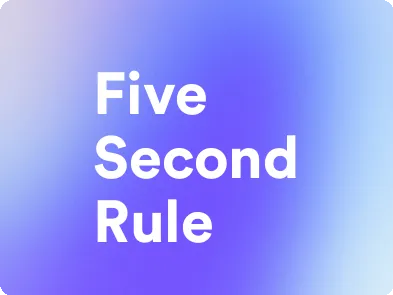The Five-Second Rule: A Productivity Game-Changer
This guide will walk you through the essential elements of using five second rule - the productivity method to keep your team productive and engaged.
Try Lark for Free
In today's fast-paced world, mastering time management and keeping procrastination at bay are crucial for success. One effective strategy that has gained significant attention is the five-second rule. This article will delve into the origins of this rule, its applicability, benefits, potential drawbacks, and practical tips for its implementation.
Understanding the Five-Second Rule
At its core, the five-second rule is a concept aimed at reducing hesitation and indecision. It encourages individuals to take action within five seconds of having an instinct to act on a goal or task. This simple yet powerful technique was popularized by Mel Robbins and has since been embraced by individuals seeking to overcome procrastination and improve productivity.
What is the Five-Second Rule in the Context of Productivity?
The five-second rule, in the context of productivity, refers to the principle of making decisions quickly and taking immediate action. It suggests that when an individual feels an urge to do something productive, they should initiate the activity within five seconds to prevent hesitation and procrastination from setting in.
Origins of the Five-Second Rule
The origins of the five-second rule can be traced back to motivational speaker and author Mel Robbins. The concept was introduced as part of her "5 Second Rule" theory, which has garnered widespread acclaim in the realm of personal development. Mel Robbins' research and insights have provided valuable understanding of human behavior and the impact of taking immediate action.
The Target Audience for the Five-Second Rule
The five-second rule is applicable to individuals from various walks of life, including professionals, students, entrepreneurs, and anyone striving to enhance their productivity. Its simplicity and effectiveness make it accessible to individuals across different industries and sectors.
Pros and Cons of the Five-Second Rule
As with any strategy, the five-second rule has its own set of advantages and limitations. Understanding these can help individuals make an informed decision about integrating it into their daily routines.
Pros
- Immediate Action: Encourages individuals to act promptly, minimizing the tendency to procrastinate.
- Boosts Confidence: By consistently acting on impulses, individuals can build confidence in their decision-making abilities.
- Enhanced Productivity: Promotes a proactive mindset, leading to increased productivity and efficiency.
Cons
- Risk of Impulsivity: Rapid decision-making may lead to impulsive actions without thorough consideration.
- Pressure: The emphasis on immediate action may create pressure for individuals who struggle with spontaneity.
- Overlooking Complex Situations: In certain scenarios, quick decisions prompted by the rule may overlook the need for thoughtful assessment.
Getting Started with the Five-Second Rule
Implementing the five-second rule into one's daily routine involves understanding its practical applications and integrating it into various aspects of daily life.
Practical Examples:
- Morning Routine: When the alarm goes off, count down from five and get out of bed immediately.
- Work Tasks: When feeling stuck on a task, count down from five and take the first step to break through the inertia.
- Fitness Commitment: Upon contemplating a workout, initiate the activity within five seconds to overcome hesitation.
By actively applying the five-second rule in these scenarios, individuals can experience its transformative impact firsthand.
Step-by-Step Guide for Applying the Five-Second Rule
Step 1: Recognize Triggers
Identify situations where procrastination and hesitation commonly arise. This could be in decision-making, task commencement, or goal pursuit.
Step 2: Embrace the Countdown
As soon as an instinct to act arises, initiate a mental countdown from five to one, and move forward without overthinking.
Step 3: Repeat and Reinforce
Consistently practice the five-second rule to instill a proactive mindset and reduce the impact of hesitation on your actions.
Actionable Tips for Effective Implementation
Key Suggestions:
- Visual Cues: Create visual reminders or cues to prompt immediate action when necessary.
- Accountability Partner: Share your commitment to the rule with a supportive individual who can help reinforce your efforts.
- Reflection and Adaptation: Regularly assess the outcomes and adjust your approach based on the results.
Do's and Dont's
| Do's | Dont's |
|---|---|
| Initiate action promptly | Succumb to overthinking and hesitation |
| Use the rule to foster decisiveness | Disregard the need for thoughtful consideration |
| Establish clear triggers | Impulsively act without evaluating consequences |
Conclusion
The five-second rule serves as a compelling strategy to conquer procrastination and drive meaningful action. While it presents both advantages and potential pitfalls, its impact can be transformative when applied conscientiously. By embracing the simplicity and efficacy of this rule, individuals can elevate their productivity and decisiveness, fostering a proactive approach to their endeavors.
Frequently Asked Questions (FAQ)
Q: Can the five-second rule be applied in professional settings?
A: Absolutely, the five-second rule can be implemented in professional environments to facilitate prompt decision-making and improve efficiency.
Q: Is the five-second rule backed by scientific research?
A: While there is ongoing research on decision-making and habit formation, the five-second rule's effectiveness is largely supported by anecdotal evidence and personal testimonials.
Q: What if I struggle to act within five seconds?
A: It's normal to initially struggle with the rule. Start by practicing in low-pressure situations and gradually extend it to more challenging scenarios.
Q: Does the five-second rule apply to complex decisions?
A: The rule is most effective for prompt, everyday actions. For complex decisions, it should be complemented with thorough consideration and analysis.
Q: Can the five-second rule help in overcoming procrastination?
A: Yes, the rule's emphasis on quick action serves as an effective antidote to procrastination, fostering a proactive mindset.
By embracing the insights shared in this article, individuals can harness the power of the five-second rule to drive impactful change in their personal and professional lives.
